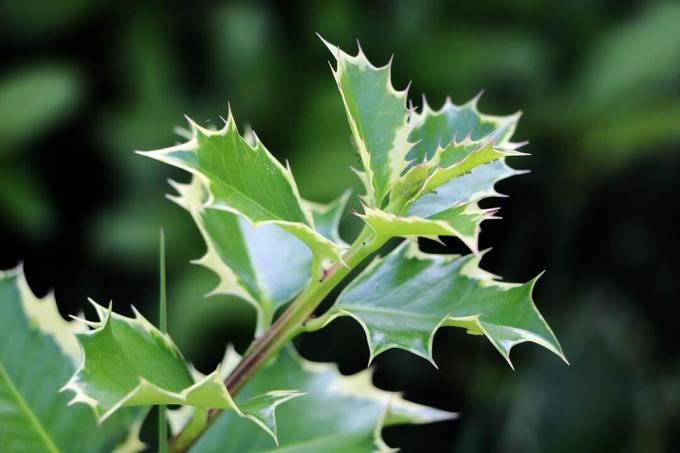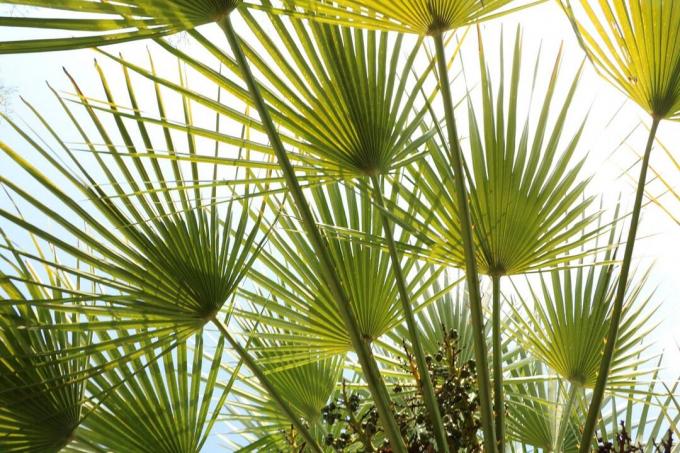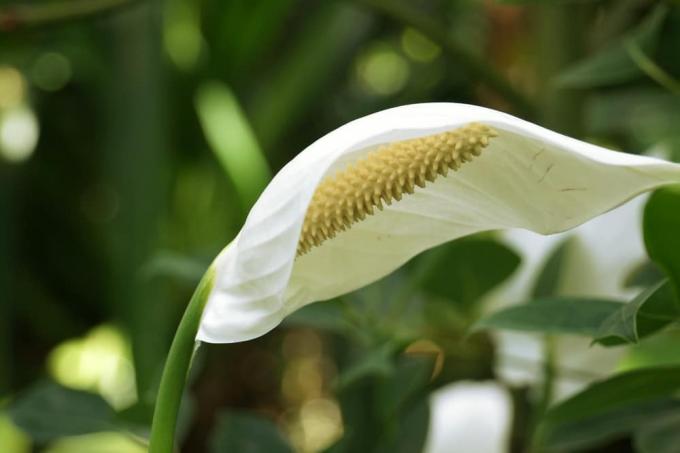
Table of contents
- Pour
- Fertilize
- temperature and light conditions
- substrate
- Cut
- hibernate
- repot
- multiply
- division
- cuttings
- Conclusion
Real papyrus comes in handy when it comes to planting marshy ground in the garden. The impressive ornamental grass impresses with 3 to 5 meter high stalks and a majestic ray flower. In order for this natural beauty to develop to its fullest, a cypergrass cannot have enough moisture at its location. What else is required to properly care for the tropical papyrus plant is explained in detail in the following instructions. This is how keeping Cyperus papyrus succeeds in an exemplary manner.
Pour
As a classic marsh grass, the papyrus plant prefers a permanently moist substrate. Therefore, it will gladly take a place on the bank of the garden pond during the summer. In view of a minimum temperature of 15 degrees Celsius, Cyperus papyrus is usually kept in large tubs. How to properly manage the water supply:
- Maintain a water level of two finger widths in the bucket
- Alternatively, constantly fill up the coaster with water
- Do not allow the water to rise to the base of the stalks to prevent rot
- Ideally water with collected rainwater, pond water or decalcified tap water
In order to create a picturesque scenery with a papyrus thicket along the stream or pond, resourceful hobby gardeners plant the ornamental grass together with a large pot in the ground. In this way, the plant can easily be lifted out of the ground when temperatures fall in autumn in order to resettle it in the winter quarters.
Tip:
If you spray Papyrus every 2 to 3 days with lime-free water, this care promotes vitality and resistance.
Fertilize
Planted out on the swampy banks of a body of water, the decorative plant naturally receives a sufficient amount of nutrients. Cultivated in tubs, the supply of phosphorus, nitrogen, potassium and trace elements in the narrow substrate volume is quickly used up. From April to August, professional maintenance requires the weekly administration of liquid fertilizer for ornamental grasses.
temperature and light conditions
In addition to the water and nutrient supply, the conditions at the site are another mainstay for properly caring for papyrus.
- Full sun location with direct sunlight for as many hours as possible
- In the semi-shade, the ornamental grass takes care of itself
- Temperatures of 18 to 25 degrees Celsius are ideal.
- The higher the temperatures, the more frequently Cyperus papyrus is treated to a spray of lukewarm water.
substrate
The elegant sour grass plant is perfect for hydro culture. Here, the perennial roots in water and not in soil. Inorganic granules, such as burnt expanded clay or other mineral substances, act as the substrate. These swim in a watertight bucket, while the plant itself is in a slotted plastic culture pot. This has the advantage that the marsh plants feel particularly at home and are self-sufficient in water. If traditional soil is preferred for keeping, it should be made up as follows:
- Nutritious in the bed, humus and fresh and moist
- As a substrate in the planter, high-quality potting soil based on compost
- Alternatively, a mix of potting soil, clay, compost and sand
Tip:
Papyrus turns into a striking focal point by cultivating it in a glass jar filled with pebbles and glass beads, half or two-thirds full with water.
Cut
The exotic ornamental grass is not cut back. In this respect, care is limited to regular cleaning of withered and dried stalks. This is more common in wind-exposed locations, especially during the summer. For competent maintenance of the impressive papyrus thicket, this measure is considered vital thinning to make room for new growth. The older the noble ornamental grass, the harder the long stalks. The resulting sharp edges can cause painful injuries. Wearing sturdy gloves is therefore mandatory for all maintenance work.
hibernate
Papyrus does not actually go into winter dormancy. Rather, it adapts to the reduced light and temperature conditions. In view of a minimum temperature of 15 degrees, hibernation under the open sky is impossible. If the cypress grass is not cultivated all year round in the living room or heated conservatory, the following precautions must be taken:
- Move Cyperus papyrus from the garden to winter quarters in late summer
- A bright, warm location with temperatures of 15 to 20 degrees Celsius is ideal
- Avoid close proximity to radiators
During the winter, the substrate is kept constantly moist. In addition, the repeated spraying of the stalks should be continued consistently. This prudence makes a valuable contribution to keeping spider mites at bay. From September to March the application of fertilizers is stopped.
repot
Their rapid growth requires a change to a larger bucket every 1 to 2 years. This should be about 10 centimeters larger in diameter and have an opening in the bottom for water drainage. The best time for this fundamental care measure is in March, before the new shoots appear. Here's how to do it step by step:
- A drainage made of grit or broken pottery prevents harmful waterlogging at the bottom of the pot
- Spread a piece of fleece over it to prevent soil crumbs from getting stuck in the drainage
- Fill the recommended substrate in the lower third of the container
- Repot the young plant and plant in the middle of the new bucket
- Do not put the ornamental grass deeper than it was previously in the ground
- Leave a high pouring rim and pour generously
If you prefer hydroponics for keeping, the repotting will follow slightly different parameters. The new hydro vessel is at least 2 sizes larger and has no bottom opening. In the first step, fill in expanded clay several centimeters high. The plant is then lifted out of the previous planter together with the culture pot. Cut several small windows 2 centimeters wide into the plastic and place the ornamental grass, including the processed culture pot, in the cachepot. Finally, the cavity is filled with hydro substrate and lukewarm water is poured up to the optimum reading on the water gauge.
multiply
The two following propagation methods have proven themselves in the correct attitude of Cyperus papyrus:
division
Since the rootstock consists of rhizomes, division is considered an uncomplicated form of breeding further specimens. Spring repotting provides an excellent opportunity to break up the root ball into several segments with a spade or axe. Each section should have at least two shoots. Plant them in individual pots to care for them immediately like adult papyrus perennials according to these instructions.
cuttings
Each crown of leaves has the potential to become an ornamental perennial in its own right. It therefore provides the ideal starting material for classic vegetative propagation. How to do it right:
- Cut a stem about 5 centimeters below a leaf tuft
- Fill a nursery pot with lean substrate
- Plant the crested cuttings 2-3 centimeters deep in it
- Water and spray with low-calcium water to initiate growth
If you put a transparent bag over the pot, a warm, humid microclimate is created underneath - ideal for the tropical swamp plant. Daily airing prevents undesirable mold growth. A fresh shoot signals the successful course of root formation in the substrate. When the young plant has fully rooted the container, repot it into substrate for mature specimens. If you are striving for hydroculture for real papyrus, the propagation of cuttings is excellently suited to steer the ornamental grass in this direction right from the start. In the waterproof growing pot there is already expanded clay in water. This is where you put the leaf crown, which allows water roots to sprout from the spot. The rooted cutting is repotted in a special culture pot, which in turn is placed in a hydro pot.
Conclusion
In order to properly care for a papyrus tree, the special requirements of a marsh plant must first and foremost be taken into account. The nutrient-rich substrate should be permanently moist, although there is nothing wrong with a permanent footbath. The tropical plant therefore feels particularly at home in hydroponics. In addition, the Zypergrass requires a full sun, warm location. Even at temperatures below 15 degrees, it gets too cold for the exotic ornamental grass. Therefore, only a warm, bright room is suitable for hibernation. Do you have the attitude of Cyprus papyrus masterfully handled, propagation by division or crested cuttings should be a gardening pleasure.
 garden editorial
garden editorial I write about everything that interests me in my garden.
Learn more about Exotic Plants

Holly, holly: care from A to Z
The European holly is one of the evergreen plants. It reaches a height of up to five meters and is ideal as a Christmas decoration or garden shrub. The native, although rarely occurring plant is the only native representative of the Ilex family and is particularly easy to care for and robust.

Dwarf palm, Chamaerops humilis: care instructions
The dwarf palm remains small enough that it can also be cared for in the room. However, it also cuts a fine figure in the garden. You can find out here how it is maintained and what needs to be considered.

Dwarf date palm, Phoenix roebelenii: Care from A-Z
The dwarf date palm (Phoenix roebelenii) is a particularly small, actually the smallest palm species of its genus. But that doesn't make them any less decorative. It is the most filigree and elegant date palm and hardly grows higher than one meter.

Growing vanilla plants: 11 tips for care
The vanilla plant is truly exotic in Central Europe and cannot be found in every garden. Vanilla planifolia forms the aromatic pods for which the plant is known. The cultivation of a vanilla plant is easily possible with the right care tips.

Kangaroo Paw: Caring for the kangaroo plant
Kangaroo paws are exotic plants native to southwestern Australia. Considering the care instructions, Kangaroo Paw can also thrive in Central European conditions. Maintenance requires a little more effort. If the plant gets enough attention, it will thank you with magnificent inflorescences.

Einblatt, Spathiphyllum: care from A to Z
Because of simple! The single sheet draws everyone's attention with its extravagant appearance. The imposing flower gives sophisticated rooms that certain something. If the houseplant is in the right place, hardly any care is required. The breeder can find out here what demands Spathiphyllum places on their location.



